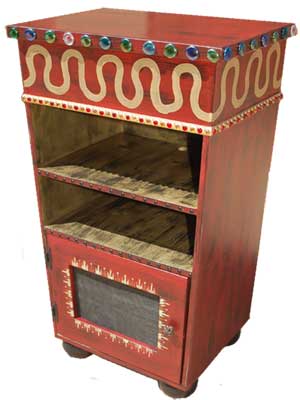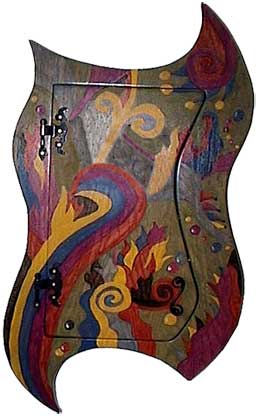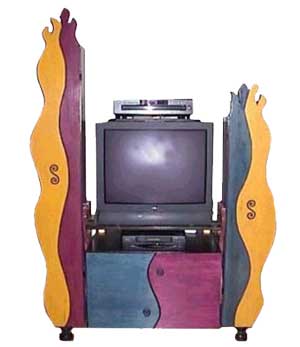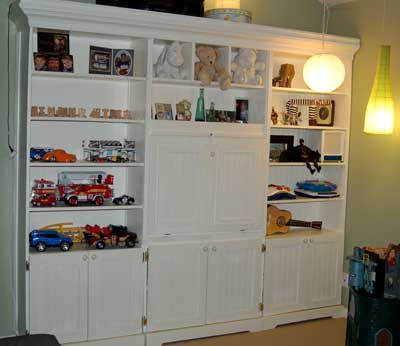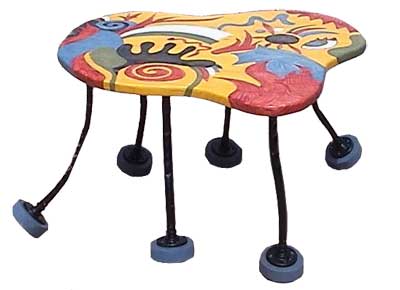
Brooke Coe’s son, aged about three at the time, helped come up with the name for Huh? Designs, her furniture and interior design company. “I was working on one of my bug tables, and I had it upside down on the bench with its legs up in the air, and I was sanding it. My son came into the garage and was like, ‘What are you doing?’ I said, ‘Oh, I’m just working on my furniture.’ He was like ‘huh’?”
Brooke had the realization, she said, “that is kind of how people react to my stuff: first it’s ‘huh’” in a questioning tone, “then ‘huh’” – in the tone of an acknowledgment.
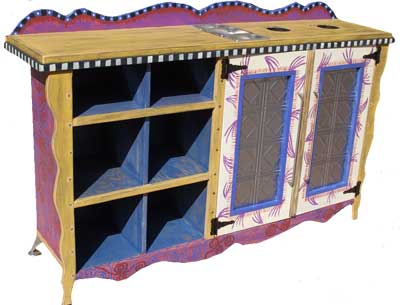
Her “stuff” includes the aforementioned bug table – a table shaped like a bug, which she’s done in a variety of iterations – furniture in the shape of other wild creatures (jellyfish, octopus), shelving units and a coffee console for an ice cream shop, and more. Most are made from woods like oak or birch, finished with colored water-based stains that allow the grain pattern to show through.
Brooke describes her furniture as freeform: since much of it has a lot of curves, her jigsaw and oscillating spindle sander are among the tools that get a workout. It’s all constructed in her shop – also known as a garage, although she hasn’t been able to park a car in it since the second week after she moved into her current home, about 10 years ago.
She lives near Los Angeles, which she says is a “very eclectic, very funky area. I love to go to Venice Beach and see the street artists, and be inspired by the emotion of their pieces.” She’ll sometimes try to recreate those emotions in her own pieces – or she’ll draw on other influences.
“I loved Dr. Seuss books growing up. I loved the randomness and craziness of the style. Then, when the Beetlejuice movie came out, and I saw the house and the furniture in that movie, it was like the drawings came to life.” The furniture from the 1988 Tim Burton movie stuck in Brooke’s mind, and later influenced her own designs.
Another early influence was rehabbing an 1890s house with her dad, starting at age nine. “My parents divorced, which is why I was a weekend at daddy’s girl. It was like ‘Today, we’re going to re-roof!’” In hindsight, Brooke said, she came to have much more appreciation for the experience she gained working with her hands and figuring out how things worked, particularly after she bought her own house in Atlanta.
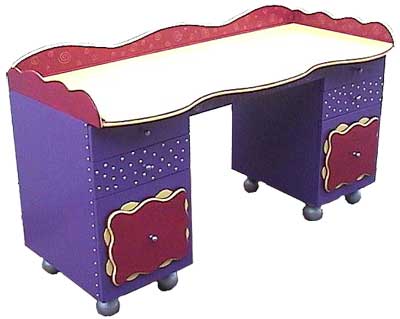
A 1947 bungalow, it had great bones, but was “ugly as sin,” she said. The first improvement project she and her husband planned was to build a deck, with built-in seating and lighting and a sunburst railing. “When they came to deliver the supplies, they had a semi-truck and a forklift, and I thought, ‘wow, they must have a lot of deliveries today.’ The entire delivery was for me. My husband and I sat there for an hour drinking our coffee, going, ‘oh, my….’ And then it was like, ‘OK, step one: make some holes for posts.’”
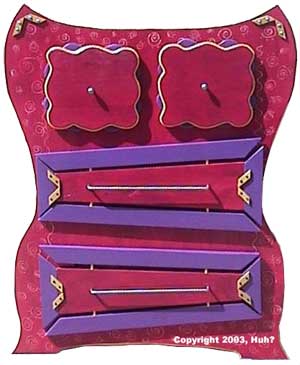
She also appreciated that her dad had Brooke, her brother and her sister do all parts of his projects: there were no boy/girl distinctions in the work. Today, “I feel kind of like an island sometimes,” as a woman in woodworking, Brooke said. For instance, she was at a large home improvement store when she needed biscuits, “and a man was like, ‘you’re not in the kitchen, honey.’ I’m like, ‘excuse me? For my biscuit joiner?’ And he didn’t even know what it was.”
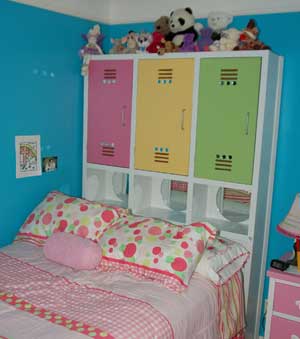
Other than her early experiences with her dad and a high school shop class, Brooke is mostly self-taught in her woodworking experience, asking for advice and opinions on how to use a specific tool as she’s needed it. Due to that background, she wanted “to make sure I had the chops” before she accepted a job a few years ago at BeJane, an online women’s home improvement community.
Brooke found an ad on Craigslist for the reality TV show “Monster House,” where teams competed to construct something crazy and win tools. Brooke was teamed, as the carpenter, with a general contractor, a welder, an upholsterer, and a movie set builder. “I knew the most as far as carpentry, except for the general contractor.” She appreciated the learning by immersion, both in that experience and at BeJane, where she worked in the marketing field.
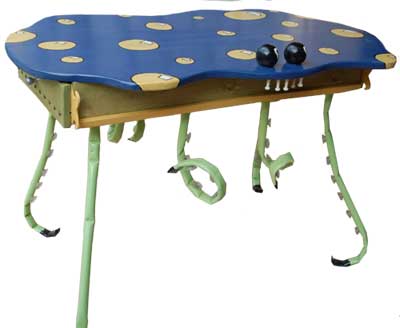
Originally, Brooke had pursued a career in advertising and marketing. She began her furniture and interior design business in 2003, and went to its current full-time status in 2006, after her employer folded. Both components of Huh Designs, she said, complement each other: “When I do an interior design job, I might have a space where I want a custom piece of furniture. When a piece of my furniture goes into a room, a lot of times people will ask about, ‘should I paint the walls?’ ‘how should I arrange this?’” She credits part of her design ability to her mother, who she said had a unique knack for putting things together.
To keep that ability to design pieces she likes, Brooke retains about 15 percent creative freedom even when working with a commissioned piece from a client’s sketch. As for her own furniture designs, “A lot of them come from my experience as a mom. I’ll want a piece for a specific function, but what I find at the store is too boring, too expensive, or not what I want.”
Examples that fall into this category are her creative/drawing table – the creativity of the table itself is meant to inspire young artists, there are drawers for storing their crayons, and they can play with the table when not drawing – and a built-in bookshelf/homework center. The latter piece solves the problem of toys taking over a room by providing storage shelves on top and cabinets on the bottom, while a latched door folds out to create a homework workstation. “I bet if I want it, other people want it,” she said.
